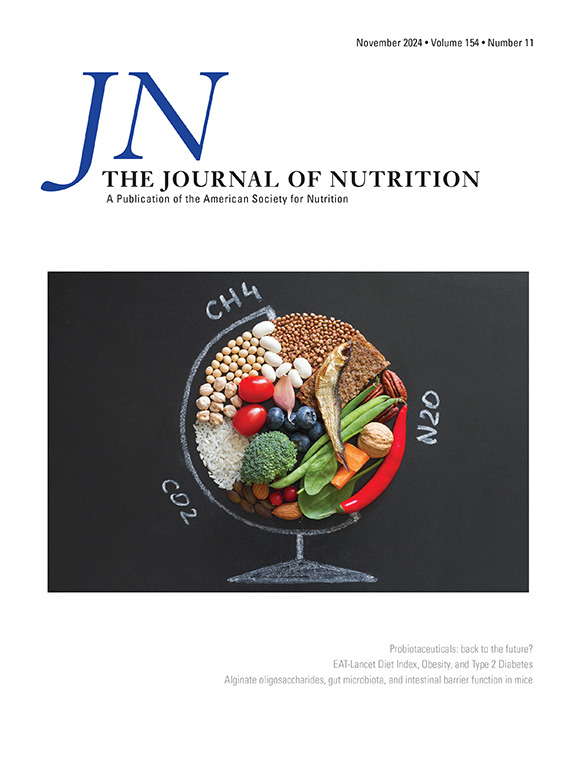普雷沃菌产生的琥珀酸盐通过增强蛋鸡线粒体功能减轻肝脂肪变性。
IF 3.7
3区 医学
Q2 NUTRITION & DIETETICS
引用次数: 0
摘要
背景:肠道菌群中较高丰度的普雷沃氏菌种类与高纤维饮食的消耗有关,并且可以通过膳食补充l -阿拉伯糖来复制。普雷沃氏菌及其代谢物琥珀酸盐对肝脏脂质代谢的影响尚不清楚。目的:探讨普雷沃氏菌及其代谢物琥珀酸盐对蛋型雏鸡肝脂肪变性的影响。方法:试验1将4周龄的Isa Brown蛋鸡随机分为4个饲粮组,分别在基础饲粮中添加0%、2%、4%和6%的l -阿拉伯糖,饲喂11周。在试验2和试验3中,10周龄的雏鸡口服普雷沃菌(106 CFU)或在饲粮中添加0.2%琥珀酸钠4周。测定生长性能、血浆脂代谢产物、肝脏脂质积累和基因表达以及盲肠菌群。在体外实验中,在不含或不含4c、琥珀酸受体1 (SUCNR1)抑制剂或shRNA-PGC1β的情况下,用普雷沃氏菌代谢物或0.1 mM琥珀酸处理鸡胚肝细胞。测定脂质沉积和线粒体功能。数据分析采用单因素方差分析,然后进行Tukey检验。结果:l -阿拉伯糖降低肝脏TG(-68%)和血浆TG(-52%),增加盲肠普氏菌丰度(+45倍)(P < 0.001)。口服黑色素普雷沃菌可降低血浆TG (-22%, P < 0.05),升高琥珀酸盐(+66%,P < 0.01)。琥珀酸盐喂养降低了肝脏(-51%,P < 0.001)和血浆TG (-40%, P < 0.05)。普雷沃氏菌和琥珀酸钠均可通过诱导线粒体功能相关蛋白降低脂肪酸合成酶(FAS)活性。体外实验表明,普雷沃氏菌和琥珀酸盐通过SUCNR1改变线粒体功能和脂质代谢,其中PGC1β起关键作用。结论:普雷沃氏菌产生的琥珀酸可能是一种通过抑制FAS活性和激活线粒体功能来减少肝脏脂质沉积的代谢物。本文章由计算机程序翻译,如有差异,请以英文原文为准。
Prevotella-Produced Succinate Alleviates Hepatic Steatosis by Enhancing Mitochondrial Function in Layer-Type Chickens
Background
A higher abundance of Prevotella species in the gut microbiota is associated with the consumption of high-fiber diets and can be reproduced by dietary supplementation with L-arabinose. The effect of Prevotella and its metabolite succinate on hepatic lipid metabolism remains unclear.
Objectives
This study aimed to elucidate the effects of Prevotella and its metabolite succinate on hepatic steatosis in layer-type pullets.
Methods
In experiment 1, 4-wk-old female layer-type chickens (Isa Brown) were randomly divided into 4 dietary groups and fed a basal diet supplemented with 0%, 2%, 4%, or 6% L-arabinose for 11 wk. In experiments 2 and 3, 10-wk-old chickens were orally administered Prevotella (106 CFU) or fed a diet supplemented with 0.2% sodium succinate for 4 wk. The growth performance, plasma lipid metabolites, hepatic lipid accumulation and gene expression, and cecal microbiota were determined. In in vitro experiment, chicken embryo hepatocytes were treated with Prevotella’s metabolites or 0.1 mM succinate in the absence or presence of 4c, a succinate receptor 1 (SUCNR1) inhibitor, or shRNA-PGC1β. Lipid deposition and mitochondrial function were measured. Data were analyzed with a 1-way analysis of variance followed by Tukey’s test.
Results
L-arabinose decreased (–68%) hepatic and plasma TG (–52%) and enhanced the abundance of cecal Prevotella (+45-fold) (P < 0.001). Oral administration of Prevotella melaninogenica reduced plasma TG (–22%, P < 0.05) and increased succinate (+66%, P < 0.01). Succinate feeding reduced hepatic (–51%, P < 0.001) and plasma TG (–40%, P < 0.05). Both Prevotella and succinate administration reduced fatty acid synthase (FAS) activity with the induction of mitochondrial function-associated proteins. In vitro experiments showed that Prevotella and succinate alter mitochondrial function and lipid metabolism via SUCNR1, wherein PGC1β plays a critical role.
Conclusions
Succinate produced by Prevotella is a likely metabolite that reduces hepatic lipid deposition by suppressing FAS activity and activating mitochondrial function.
求助全文
通过发布文献求助,成功后即可免费获取论文全文。
去求助
来源期刊

Journal of Nutrition
医学-营养学
CiteScore
7.60
自引率
4.80%
发文量
260
审稿时长
39 days
期刊介绍:
The Journal of Nutrition (JN/J Nutr) publishes peer-reviewed original research papers covering all aspects of experimental nutrition in humans and other animal species; special articles such as reviews and biographies of prominent nutrition scientists; and issues, opinions, and commentaries on controversial issues in nutrition. Supplements are frequently published to provide extended discussion of topics of special interest.
 求助内容:
求助内容: 应助结果提醒方式:
应助结果提醒方式:


